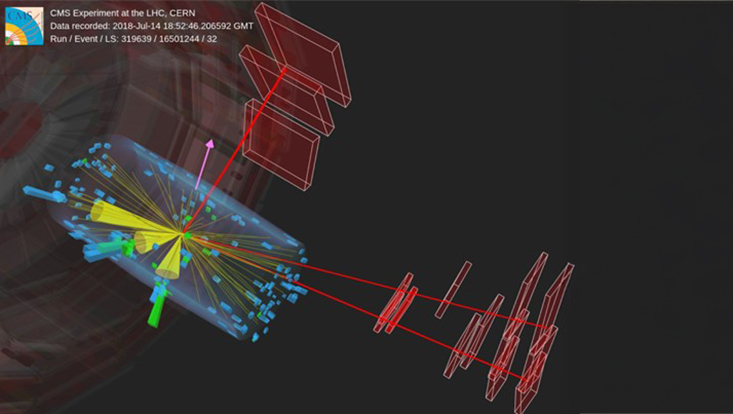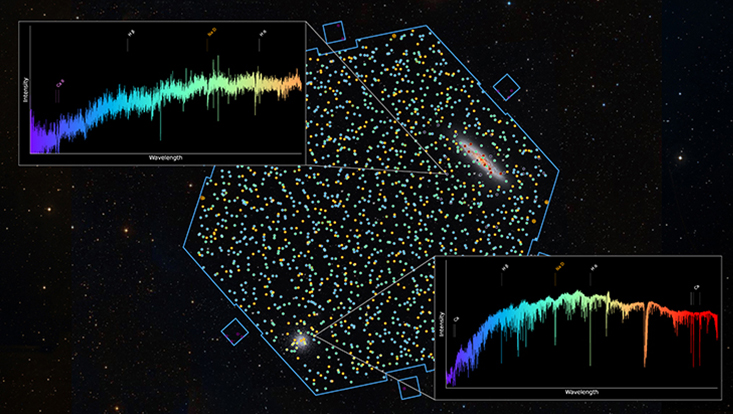and Natural Sciences
Only 26 light years away and potentially with atmosphere:A blazing super-Earth
5 March 2021, by MIN-Dekanat
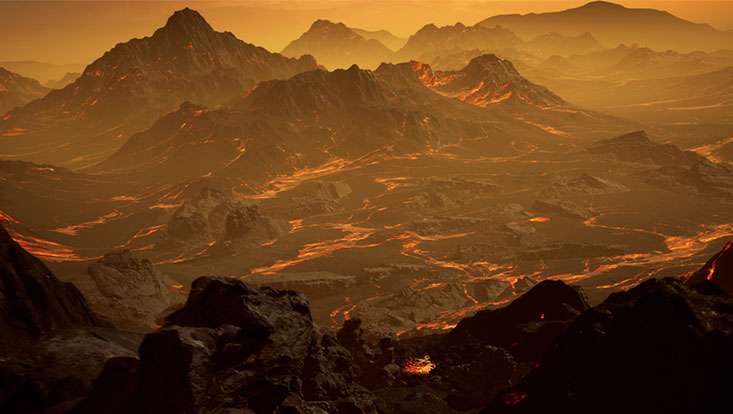
Photo: RenderArea, https://renderarea.com
Astronomers from the international CARMENES consortium, with participation from the University of Hamburg Observatory, have published a study reporting the discovery of a hot super-Earth orbiting the nearby red dwarf star Gliese 486. The scientists published their results in the journal Science.
With the advent of efficient exoplanet-hunting facilities, the numbers of newly discovered worlds outside the Solar System quickly rose to thousands. By combining different observing techniques, astronomers have determined planetary masses, sizes, and even bulk densities, allowing them to estimate their internal composition. The next goal to fully characterise those exoplanets similar to Earth by studying their atmospheres is much more challenging. Especially for rocky planets like Earth, any such atmosphere consists of a thin layer, if it exists at all. As a result, many current atmospheric models of rocky planets remain untested.
Planetary atmospheres must meet specific prerequisites to observe them with next-generation observatories. At a distance of only 26 light-years, scientists of the CARMENES (Calar Alto high- Resolution search for M dwarfs with Exoearths with Near-infrared and optical Échelle Spectrographs) consortium now have found a planet orbiting the red dwarf star Gliese 486 that perfectly satisfies these specifications for rocky planets. This makes it sufficiently nearby to allow it to be studied in more detail with the upcoming James Webb Space Telescope and the various Extremely Large Telescopes.
"With this planet, we are lucky! Everything is right here: the distance to us, the distance to its host star, its orbit, its mass and its size," says Dr. Andreas Schweitzer of the Hamburg Observatory and co-author of the study.
The newly discovered planet designated Gliese 486b is a super- Earth with a mass 2.8 times that of our home planet. It is also 30 % bigger than Earth. The scientists employed both transit photometry and radial velocity spectroscopy to obtain their results. By calculating the planet’s mean density from the mass and radius measurements, its composition appears similar to Venus and Earth, including a metallic core. Anyone standing on Gliese 486b would feel a gravitational pull that is 70 % stronger than what we experience on our world.
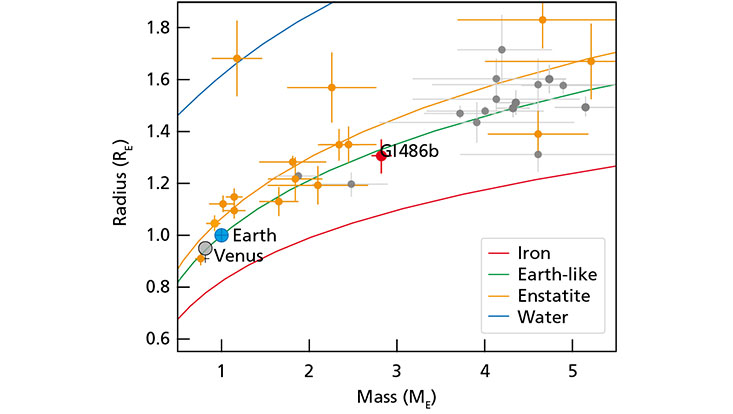
Gliese 486b revolves around its host star on a circular trajectory within 1.5 days and at a distance of 2.5 million kilometres. One rotation takes the same amount of time, so one side always faces the star. Although the star Gliese 486 is much fainter and cooler than the Sun, the irradiation is so intense that the planet’s surface heats up to at least 700 Kelvin (approx. 430 °C). In this sense, Gliese 486b’s surface probably looks more like Venus than Earth, with a hot and dry landscape interspersed with glowing lava rivers. However, unlike Venus, Gliese 486b possibly only has a tenuous atmosphere if any. Model calculations may be consistent with both scenarios because stellar irradiation tends to evaporate atmospheres. At the same time, the planet’s gravity helps to retain it. Figuring out the balance of those contributions is difficult.
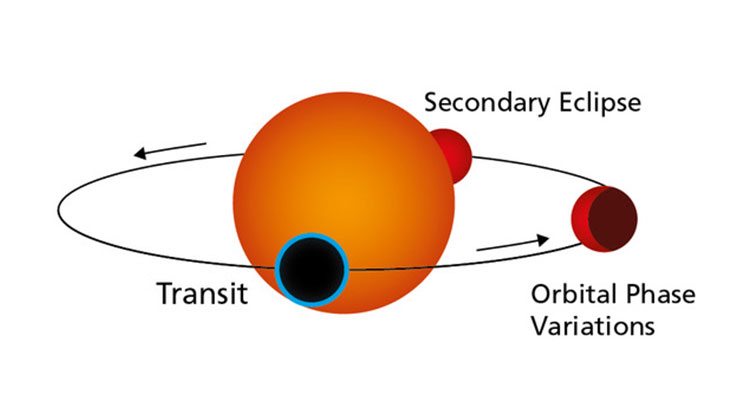
The future measurements that the CARMENES team have in mind exploit the orbital orientation, which causes Gliese 486b to cross the surface of the host star from our point of view. Whenever this happens, a tiny fraction of the stellar light shines through the thin atmospheric layer before it reaches Earth. The various compounds absorb light at specific wavelengths, leaving their footprint in the signal. By using spectrographs, the astronomers split up the light according to wavelengths and look for absorption features to derive the atmospheric composition and dynamics. This method is also known as transit spectroscopy.
"This newly discovered planetary system has the ideal orientation. We see it from the side! Thus, we can study the planet's atmosphere through transit spectroscopy almost like in a laboratory. We are already excited to see what the comparison with our computer simulations of planetary atmospheres, which we are performing in Hamburg, will reveal," explains Dr. Schweitzer.
A second spectroscopic measurement, called emission spectroscopy, is planned when parts of the illuminated hemisphere become visible like lunar phases during Gliese 486b’s orbit until it vanishes behind the star. The spectrum contains information on the bright, hot planetary surface.
When the new telescopes are available, scientists will use Gliese 486b to study how well rocky planets can hold their atmospheres, what the gas mixtures are made of, and how they influence the energy distribution on the planets.
Text: MPIA, red.
Original publication
T. Trifonov, J. A. Caballero, J. C. Morales et al. (2021): A nearby transiting rocky exoplanet that is suitable for atmospheric investigation, Science, Vol. 371, Issue 6533, pp. 1038-1041
DOI: 10.1126/science.abd7645
The CARMENES-Project
The CARMENES-project is a consortium comprising eleven research institutions in Spain and Germany. Its purpose is to monitor some 350 red dwarf stars for signs of low-mass planets using a spectrograph mounted at the 3.5 m Calar Alto telescope (Spain). This study includes additional spectroscopic measurements to infer Gliese 486b’s mass. The scientists obtained observations with the MAROON-X instrument at the 8.1 m Gemini North telescope (USA) and retrieved archival data from the 10 m Keck telescope (USA) and the ESO 3.6 m telescope (Chile).
Photometric observations to derive the planet’s size stem from the TESS (Transiting Exoplanet Survey Satellite) spacecraft (NASA, USA), the MuSCAT2 (Multicolour Simultaneous Camera for studying Atmospheres of Transiting exoplanets 2) instrument mounted at the 1.52 m Telescopio Carlos Sánchez at Observatorio del Teide (Spain), and the LCOGT (Las Cumbres Observatory Global Telescope), among others.
Website: https://carmenes.caha.es

